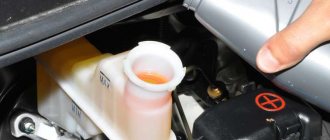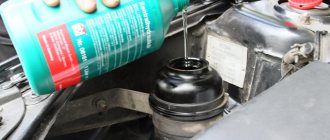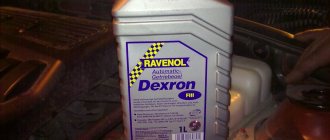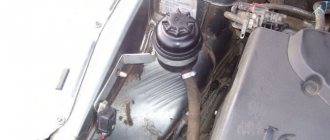Analogue or original? Which gur to choose
Let's start with the original and move on to analogues along the way.
The car used one version of the hydraulic booster for absolutely any configuration and engine. There are two articles in the catalog: 57100-4L000 and 57100-4L001. Before 2015 it was set to 57100-4L000, after - the next one. I don’t know what’s causing the number change. Everything is the same.
The hydraulic booster has been used by the company since 2006. and has two additional articles that are not in the catalog: 57100-2F601 and 57100-1M000.. The differences are in the tube and metal bracket, which can be rearranged from the old pump. Usually the price of these is lower.
Difference in bracket and tube
Need a new original, use all numbers. Ask sellers to announce the price for each number. They usually only use directory data.
Recently, the story about MANDO+ has been widespread. MANDO+ is no different from most cheaper analogues.
What is the main difference between the original and analogues? Advantages and disadvantages.
- Minuses:
- All other things being equal, the resource is lower.
- There is a marriage. It doesn't happen often, but it does happen. After installation, the buzzer may hum for some time. You'll have to travel for up to two or three days. The howling does not go away, which means the pump is defective. Always keep your receipt.
- There may be no or a different type of sensor responsible for the stability of idle speed when the steering wheel is rotated. Without it, the engine may shake a little.
Steering sensor
- Pros:
- The difference in price is up to 3.5 times.
- A decent resource in most cases.
- Easy to buy, stores keep duplicates in stock. The original usually needs to be ordered and waited.
Below is a list of manufacturers and numbers of hydraulic boosters. The items that were used in the repair are marked in green. No other experience.
Analogs
I will add SAT and STELLOX power steering. Usually the cheapest options.
Company guide SAT ST-VP70
STELLOX 00-36351-SX
Gur in Solaris, what is it? Hydraulic power steering.
Actually, it is needed to make it easier to turn the steering wheel. But there are also many other useful properties. Thanks to the Solaris hydraulic booster, from
The steering wheel doesn't get hit by uneven road surfaces, and even if a tire blows out, you still won't lose control.
Maneuverability will be much higher than that of a car without steering wheel, control is easier, almost all the power work is done for you by the Solaris hydraulic booster, therefore, it will take you much less time to make a turn or turn.
Well, the most wonderful thing is that if suddenly, which very rarely happens, you get into trouble, then you will have the opportunity to once again enjoy the pleasant feeling of driving a five from a driving school). If the Solaris power steering breaks down, it doesn’t matter, you can control it. And if you have long been haunted by the desire to pump up your hands, then you don’t have to do any repairs at all.
The steering wheel is an extremely unpretentious thing and despite the fact that it breaks very rarely, sometimes you can still encounter problems, and it won’t hurt you to know how to calculate and fix them.
When to change and what kind of oil to fill in?
There is no information about oil in the manual. Not a word at all. There is not even a recommendation on when to replace it. This is the first time I have encountered such a situation. Apparently, when the manual was written, it was supposed to install an electric booster, which was equipped with cars for markets in other countries.
Due to a lack of information, the opinion was formed that PSF-3 liquid was initially filled. In fact PSF-4. Questions immediately arise: can PSF-3 be used? If necessary, add oil, is it possible to mix them?
Liquid PSF-4, article number 03100-00130
Liquid PSF-3, article number 03100-00110
When changing oil, you can use PSF-3. It was this that was used in our pump earlier, even before the appearance of the machine itself. PSF-4 costs twice as much. It is believed that its service life is longer than the price of the oil is justified. In fact, the replacement intervals are the same.
Another strange point is the availability of oil characteristics and properties. Information is available for PSF-3, but not for PSF-4.
Properties and characteristics of oil PSF-3 03100-00110
Minimum information PSF-4
Let's look at the most common questions.
- Can different oils be mixed?
- What to fill in instead of the original?
- Will regular ATF work?
- Why change the oil if the service manual does not indicate such work?
- Replacement timing or how to determine the need for an oil change?
1) PSF-3 and PSF-4, it is allowed to mix in a volume of no more than 50%. PSF-4 liquid may be colorless, yellow or green. PSF-3 is usually red. Identical oils can be mixed, even if the color is different.
2) Kixx and ZIC have proven themselves well.
Kixx PSF oil, article number L2508AL1K1
Oil ZIC PSF-3, article 132661
3) Once upon a time there was no specialized oil. We used regular ATF. The main difference is in the dynamic characteristics of viscosity, which are more optimal over almost the entire operating temperature range. There are no additive packages intended for automatic transmission clutches, which are simply not available in hydraulic boosters.
In practice, some clients use conventional ATF. As long as the oil change intervals are observed, everything is fine, even at high mileage.
ATF
4) Any oil loses its properties over time. The rubbing surfaces in the steering rack distributor and power steering form wear products. They accumulate in the oil itself, working as an abrasive.
Many modern systems have a replaceable paper filter. We don't have such a solution. Our car does not have a cooling circuit. Therefore, our replacement intervals are relatively short. Remember: those who don’t change the oil will pay for a new steering wheel and steering rack in the future.
5) Replacement periods depend on the fluid manufacturer and operating mode.
Below is a table with average values for original oils. Oil change intervals
| City | Mixed | City |
| 40 000 | 60 000 | 80 000 |
To make sure that replacement is necessary, use a syringe to remove the old oil from the power steering reservoir. It should be transparent, without a burning smell. If the liquid is cloudy, change it; dragging it further will cost more.
What will be needed for repairs?
- A pair of jacks (to raise the front on both sides)
- 20 ml syringe and a tube on the tip (can be from a dropper or catheter)
- Screwdriver Set
- Pliers
- A plug for the hole in the tank; for this, take a regular rubber tube 30-50 (cm) in diameter of the return hose, which is clamped with a clamp (to create compression)
- Extension cord with a fitting for installation on the return hose (length about 3-4 meters)
- Container for collecting waste liquid
- New oil (experts recommend using PSF-3)
If you are changing the oil in the Hyundai Solaris power steering, please note that the oil tank itself has a volume of 0.8 (l). But when the hydraulic system begins to pump oil, then somewhere else 0.2 (l) is distributed through the pipes
So. for a complete oil change you will need not 0.8 (l), but a whole liter.
What oil is best to fill in the power steering?
Currently, all power steering oils can be divided into two types: mineral and synthetic. There are active discussions among domestic motorists about which oil is better, while the car manufacturers themselves recommend using mineral lubricants.
This is explained by the fact that synthetics have a detrimental effect on the rubber parts of the power steering due to the chemical aggressiveness of the substances that make up the oils. The use of synthetics is relevant for rubber parts made of a special composition; recommendations for the use of such oils are indicated by the car manufacturer.
Based on color and shade, power steering oils can be divided into three types:
- Red (natural and synthetic lubricants of the Dexron family, mixing is prohibited!);
- Yellow (natural oils used in power steering systems of most modern cars);
- Green (natural and synthetic oils used for power steering systems of cars manufactured in France are prohibited from mixing!).
To avoid negative consequences, accelerated wear and expensive repairs, it is important to remember that mixing mineral and synthetic oils is strictly prohibited. Mixing red and yellow lubricants is allowed, while green power steering oils are prohibited from mixing with any other
This is interesting: Step-by-step instructions on how to reset service intervals for cars yourself
Selecting steering fluid for Hyundai Solaris
To guarantee the service life of the unit, the South Korean manufacturer specially produces technical fluids for its cars. You can find out exactly what fluid to fill in the power steering by referring to the user manual or to official dealers.
Today, stores offer a large number of different brands, which differ in color, composition, and additives included in the solution. Green synthetic oils are most preferred. Substance class – D3.
Hyundai Solaris power steering fluid, recommended by the manufacturer, has the following name - Hyundai Kia ULTRA PSF-4. For earlier models, you can find a recommendation that the use of Hyundai Kia ULTRA PSF-3 is allowed. Mixing them together is allowed in the following cases:
- PSF-4 can be added to PSF-3, but not more than 50% of the total volume, if PSF-3 was initially poured into the system;
- if it is necessary to top up PSF-4, the volume of which is more than 50% of PSF-3, complete drainage is required;
- If PSF-4 was initially filled, adding PSF-3 in any amount is prohibited.
In most cases, you should not pay attention to color, since this factor does not characterize the base on which the liquid is made. You should only rely on the markings
How to change oil in gur
Let's consider two methods: update and complete replacement.
Update. Work is performed every 20 thousand km. 1 liter of new oil is enough. You won’t have to remove the tank and clean the mesh in it, deal with hoses, containers and pumping the system.
It is enough to remove the supply hose or pump out the old oil from the tank with a syringe. Next, fill in a new one and set the level, which should be between o and “MAX” in the “COLD” zone. After driving a little, check the level; it should rise to the “HOT” zone.
Remove the supply hose and drain the oil
Oil level
Complete replacement. Two liters of new oil are needed. When you drain the old one, look inside the tank. The mesh must be clean. If not, remove and wash with brake cleaner, carburetor cleaner or degreaser, or regular gasoline.
Mesh in the tank
Prepare a container for draining with a volume of at least 1.5 liters. Remove the return hose from the tank and immerse it in a container. We select a suitable hose for the tank and lead it up.
This is what should happen. We position the drain so that we can see the flowing oil.
Fill in new oil. Full tank.
Now it is necessary to expel the remaining old oil from the system. There are two ways to go here. Fast and slow.
Fast. We start the engine. If you do the work alone, let the engine run for 2-3 seconds and add fluid to the reservoir. If you have an assistant, carefully monitor the level in the tank and give the signal to turn off the engine in advance, without waiting for it to be empty.
Fill the tank full again and repeat the procedure until clean, fresh liquid comes out of the return hose. Usually it takes 1.5-1.6 liters.
Slow. The only difference is that the work is done with the engine turned off. Rotate the steering wheel from lock to lock, monitoring the level in the tank and adding as it goes down. Turn the steering wheel until fresh, clean oil flows out of the hose.
It remains to set the oil level, as described at the beginning of the section.
Step-by-step instruction
You can change the technical composition yourself within 30 minutes. Details can be found in the video instructions, but an experienced car owner can easily cope without additional help.
To start the process of replacing the Hyundai Solaris power steering fluid you will need:
- standard set of tools;
- a convenient place where you can lock the car;
- funnel;
- a syringe with a volume of more than 150 ml, with which you can fill the composition;
- 2-3 containers, preferably plastic.
The change is made in several stages:
- the composition is pumped out from the expansion tank, a syringe is used for this;
- use pliers to loosen the clamp connecting the tank to the return pipeline;
- the end of the hose is discharged into one of the free containers;
- the steering wheel is turned several times by hand in both directions to completely free the system from fluid;
- the tank is inspected to find sediment; if sediment is detected, the sediment is washed out using a special product;
- the upper hose is returned and fixed, the lower hose is removed and lowered into the prepared container;
- while constantly rotating the steering wheel, drain the old fluid while adding new fluid;
- the lower pipeline is returned to its place and secured, the tank is filled with power steering fluid to the lower mark;
- The car starts and warms up; if foam appears, the steering wheel should be turned until the air lock is completely removed.
- The replacement process is complete; if liquid gets on painted body parts, it should be immediately washed off with a degreaser (solvent).
Diagnostics and malfunctions of the hydraulic booster
There are only three main problems.
- Oil seal leak, number 4 - Dimensions 20x36x7. It is better to buy an original repair kit, the price of which remains affordable.
- Bearing, number 5 - Original number 57143-3A000, analogue of FAG 62032RSRC3.
- Stator and rotor, number 3. Duplicate version NI001ROTOR. Original 57115-33500. In case of wear, there is a high probability of replacing the entire steering wheel. Often parts simply cannot be found on sale.
Spare parts are intended for the original pump. For other manufacturers, part sizes may vary!
In most cases, repairs are much cheaper than even purchasing a Chinese pump.
Gur device
The seal will betray itself by fogging or leaking.
First fogging, then leaking
With a bearing it is more complicated; the problem does not manifest itself in only one specific situation. For example, the noise may be present when it is cold and go away as it warms up, or disappear when you turn the steering wheel. It may just make noise without reacting to the steering wheel. When the temperature changes outside, it may disappear and appear.
Bearings of other mounted units may make similar sounds. You need to listen carefully to where the noise is coming from. The sound should be louder in the gur area. You can place your finger on the bolt that secures the hose to the pump. If you feel distinct impacts, the bearing is giving out. Such simple diagnostic methods are sufficient in most cases.
The video shows examples of the noise of a collapsed bearing.
Your browser does not support the format
When the pump part is worn out. The steering wheel makes a howling noise when turning the steering wheel or always. The working pressure in the system does not develop and the steering wheel becomes stiff. Changing the oil doesn't help. Here, before carrying out repairs, you need to find out the availability and price of spare parts.
Advantages of repairing Solaris power steering in our car services
The process of changing power steering oil is the same in almost all cars. In some Hyundai brands, for example, Hyundai Tussan, Hyundai Matrix and Hyundai Accent, it is recommended to flush the system, since the power steering mechanism in these models is more susceptible to wear. The main difference lies in the choice of oil itself.
As stated earlier, power steering fluid is available in three types:
- The red solution can have a synthetic or mineral base and is most often poured into the automatic transmission of Toyota Kaldina and Hyundai Sonata cars. In some cases, such fluid is also suitable for Hyundai Elantra hydraulics;
- Yellow oil is considered universal and is suitable for all types of power steering. Can be used in cars with automatic and manual transmissions, such as Audi Q7, Mazda 3 and ZAZ Chance.
The green solution is the rarest. Previously, such a product was also used in hydraulic systems, but now it is only poured into mechanical gearboxes.
Hyundai Solaris power steering fluid requires regular topping up as the car is used, but some drivers often change it completely, while flushing the reservoir to remove sediment.
https://www.youtube.com/watch?v=ytcreatorsru
High-quality replacement of the pump is carried out only if certain points are observed:
diagnosing faults is an extremely necessary procedure; it is important to understand why the breakdown occurred; pump repair; cleaning elements from leaked liquid; replacing a damaged belt; bearing replacement; power steering fluid update.
From the variety of workshops, it is important to choose a good service. We offer our maintenance service for the following reasons:
- The specialists who carry out repair work are qualified and have extensive experience.
- The service is equipped with the most modern equipment necessary to eliminate breakdowns.
- We guarantee the quality of our services.
- We update quickly and strictly on time.
- The established prices will be affordable for many customers.
Vehicle malfunction is a serious problem for all motorists. For many people, a car is a means of earning money.
It is very important for such drivers that the car functions smoothly; for this it is necessary to follow certain recommendations:
- technical inspection cannot be ignored, this manipulation can be carried out in our service center;
- change your aggressive driving style to a calmer one;
- use only high-quality hydraulic power steering fluid;
- respond to problems that arise in a timely manner, rather than delay their elimination.
Your comfort and safety while traveling depends on careful care of your vehicle. The longevity of your car is directly related to the way you handle your vehicle. Be attentive to the car, and then it will not let you down.
How to replace or remove the hydraulic booster
The gur is located between the engine and the engine shield. Before work, it is necessary to drain the fluid from the system.
Remove the drive belt. If the work is carried out in a garage without a pit, it is better to remove the wheel and use a 14 key to press the tensioner towards the engine shield. There is no tension, the belt can be removed by hand. For more details, see the “Drive Belt Tensioner” section.
Unscrew the lower hydraulic booster mounting bolt.
Let's go to the engine compartment. Remove the chip and disconnect the wiring from the bracket. If a non-original steering wheel is installed, the sensor may be missing.
Unscrew the power steering hose (green arrows) and the upper mounting bolt (yellow arrow).
All that remains is to remove the bracket and the return tube. You can disassemble it on the car or the removed power steering.
Engine rear view
Definition of hydraulic oil
What is hydraulic fluid, and what kind of oil should I pour into the power steering? First of all, it is a technical liquid. Its properties are determined based on the set of functions that a hydraulic fluid should have:
- transmission of force from the steering wheel to the power steering pump, and then from the pump to the steering mechanism;
- protection against friction of all elements of the hydraulic booster system;
- heat removal or thermoregulation of power steering mechanisms.
Based on the properties, each automobile company selects its own version of hydraulic fluid. From this it becomes clear that there are quite a few varieties of hydraulic oil.
Main functions of Hyundai Solaris power steering oil
Hydraulic fluid plays an important role in the operation of the entire Hyundai Solaris power steering unit; its main function is to transfer energy from the power steering pump to the pistons of the steering mechanism and cool the entire unit. Also, thanks to Hyundai Solaris power steering fluid, the operating life of all parts of the mechanism is greatly increased, it prevents the occurrence of corrosion and oxidation processes. In addition to these properties, the lubricant significantly reduces friction between elements and prevents overheating of power steering parts. If the oil level is insufficient and the quality is unsatisfactory, complete failure of the entire mechanism may occur.
Signs that you need to replace power steering fluid in a Hyundai
Hydraulic fluid is a special technical fluid that transmits resistance from the steering wheel to the pump, which greatly facilitates the rotation of the steering mechanism of the Hyundai Solaris. This way, the driver can set the vehicle’s trajectory without exerting significant effort.
In addition to its main function, the power steering solution also lubricates mechanisms and protects hydraulic parts from excessive friction, removes heat, and removes mechanical particles of dirt and dust. When the engine is running, the liquid can lose its properties after a certain mileage. If you do not change the fluid in a timely manner, at the most unexpected moment the steering wheel may stop turning, which will create an emergency situation on the road.
This is interesting: Installing running lights on a car with your own hands: important rules for installing DRLs
If the oil level in the system is insufficient, the mechanism will run dry. This leads to failure of the main power steering elements: pump, hose, metal parts and steering rack. Repairing them will cost the driver dearly.
According to the maintenance regulations, the power steering fluid in the system must be replaced every 90,000 km. However, other factors may also affect the frequency of oil changes:
- Intensive use of the vehicle;
- Frequently fixing the steering wheel in the extreme position;
- Parking a car for a long time with the front wheels pulled out.
The most effective way to check a fluid is to visually inspect it. Over time, the solution darkens, acquires a burning smell, and its composition is dominated by a large amount of dirt and rust. This can be easily detected by looking under the hood of the vehicle. In order to check the liquid, you need to pour a small amount of solution onto a white sheet of paper using a dipstick.
The spent liquid will not be able to perform its functions fully; it must be replaced.
Power steering hums after replacement
Sometimes the power steering starts to hum after an oil change. Unpleasant sounds can be caused by the pump if the system has been filled with oil that is less thick than it was before. The fact is that between the inner surface of the stator ring and the rotor plates the output increases. Vibration of the plates also occurs due to the unevenness of the stator surface.
To prevent such a situation, we advise you to use the oil recommended by the manufacturer. This will protect your car from system breakdowns.
It is also possible that a hum may occur after replacing the high-pressure power steering hose. One of the reasons may be a poor-quality hose. Some service stations make the mistake of installing ordinary hydraulic hoses instead of special hoses designed for high pressure and operation in the power steering system. This can cause airing in the system and, accordingly, a hum. The remaining reasons are completely similar to the cases listed above (knock on cold, hot).
Choice of composition for power steering
The performance and service life of the unit depends on the production and quality of the liquid that is poured into the Solaris power steering. It is always better to opt for authentic products from the Korean automaker.
Its price may be slightly higher than its analogues, but road safety requires the use of only high-quality factory-made compounds and oils. Competitors may make products just as good, but you should only use them after consulting with your dealer.
It is better to buy a Hyundai Kia ULTRA PSF-4; the technical documentation for early generation versions allows the possibility of using ULTRA PSF-3. Knowing what brand of fluid has already been filled into the Hyundai power steering, you can determine the mixing order.
Mixing is carried out according to a strict rule: the fourth brand can be poured into the third, but not more than 50% of the total amount of the mixture. The reverse situation is excluded.
How does the power steering system work?
To better understand the concept of hydraulic fluid and what kind of oil to pour into the power steering, let’s look at how the entire system works. There are not many elements included in the hydraulic power steering system:
- power steering pump;
- fluid reservoir;
- steering gear;
- connecting hoses and tubes.
The main working element of the system is, of course, the power steering, or simply power steering. It is this that creates pressure in the system, which is transmitted through hydraulic fluid through connecting pipes and tubes to the steering mechanism. Thanks to this, the main work of turning the wheels falls not on the driver’s hands and steering wheel, but on the power steering system.
It is important to remember that the hoses and tubes coming from the power steering are under high pressure and require special attention. And they should not be confused with the “return”, which flows back into the reservoir with the liquid.
Reasons for dirt getting into the system
Why does power steering oil foam? Another reason for this is contamination of the power steering. How dirt can get into it:
- the fittings are clogged;
- the filter in the tank has become unusable;
- the hoses ruptured.
Let's look at each reason why power steering oil foams in detail:
1. The hose ruptured.
In this case, the only thing you can do is install new hoses to replace the broken ones.
2. The fittings are clogged.
To clean them, you must perform the following steps:
- dismantle the wheels;
- using an eight key, remove the protective cap;
- attach a hose with a diameter of 6.5 mm to the fitting;
- use this hose to remove grease;
- to prevent the oil from falling below the minimum mark, simply add lubricant to the power steering reservoir;
- Have you noticed that there is oil coming out of the fitting that does not foam? This means that the work was done efficiently;
- Now let's start pumping the power steering. To do this, turn the steering wheel all the way left and right while the engine is running.
We recommend
“Steering wheel knocking when driving: causes and methods of elimination” More details3. The filter is clogged.
To replace it, you will have to find the power steering reservoir. It's usually located under the hood, you'll notice it right away. What to do next:
- dismantle the tank cover;
- remove grease;
- remove the old filter and install a new one.
If the reason why the oil foams in the hydraulic booster was a dirty filter, then after all the manipulations carried out the machine will function normally.
At first glance, it may seem that there is nothing wrong if the oil in the power steering foams. However, this problem can lead to a dangerous accident. It is recommended to eliminate the malfunction as quickly as possible, and the repair must be done efficiently. The work should be carried out carefully, and after completing all the manipulations, it is necessary to check whether the hydraulic booster is functioning properly.
In reality, only every fourth driver can eliminate air from the power steering 100%. This means that when you find that the oil in the power steering is foaming, you should immediately go to a trusted car service center. After all, driving a car with such a breakdown can lead to a serious accident.
Signs that you need to replace power steering fluid in a Hyundai
Hydraulic fluid is a special technical fluid that transmits resistance from the steering wheel to the pump, which greatly facilitates the rotation of the steering mechanism of the Hyundai Solaris. This way, the driver can set the vehicle’s trajectory without exerting significant effort.
In addition to its main function, the power steering solution also lubricates mechanisms and protects hydraulic parts from excessive friction, removes heat, and removes mechanical particles of dirt and dust. When the engine is running, the liquid can lose its properties after a certain mileage. If you do not change the fluid in a timely manner, at the most unexpected moment the steering wheel may stop turning, which will create an emergency situation on the road.
Read more: Toyota Avensis throttle training
If the oil level in the system is insufficient, the mechanism will run dry. This leads to failure of the main power steering elements: pump, hose, metal parts and steering rack. Repairing them will cost the driver dearly.
According to the maintenance regulations, the power steering fluid in the system must be replaced every 90,000 km. However, other factors may also affect the frequency of oil changes:
- Intensive use of the vehicle;
- Frequently fixing the steering wheel in the extreme position;
- Parking a car for a long time with the front wheels pulled out.
The most effective way to check a fluid is to visually inspect it. Over time, the solution darkens, acquires a burning smell, and its composition is dominated by a large amount of dirt and rust. This can be easily detected by looking under the hood of the vehicle. In order to check the liquid, you need to pour a small amount of solution onto a white sheet of paper using a dipstick.
The spent liquid will not be able to perform its functions fully; it must be replaced.











